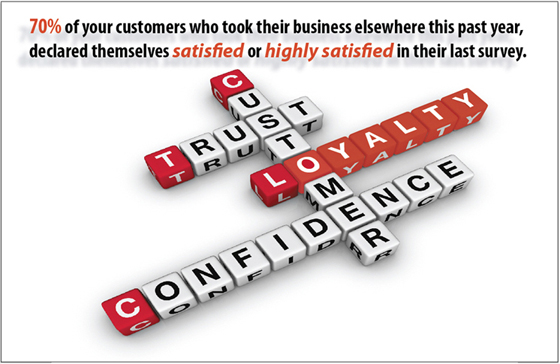|





> The LoyaltyPro
Advantage >
Loyalty Index
Loyalty Index

Josiah Royce, an American philosopher
in
the
mid
to
late
1800’s,
claimed
that
the
trait
of
loyalty
was
most
often
associated
and
driven
by 4
main
aspects
of
an
individual’s
life
–
political
institutions,
religion,
war,
and
family.
Basically,
that
it
is
the
relationships
a
person
has,
the
“work”
they
do,
and
the
organizational
structures
they
are
a
part
of
that
drives
their
personal
loyalties.
Translating what Royce says about personal
loyalties
into
the
world
of
business
- it
can
be
said
that
the
primary
aspects
and
drivers
of
loyalty
in a
business
relationship
are
PEOPLE
(Relationships),
BUSINESS
(Work),
and
ORGANIZATION
(Structure).
These are the foundational principles
upon
which
the
Loyalty
Index
(and
methodology)
has
been
built.
Proven to be a better predictor of
future
customer
behavior,
the
Loyalty
Index
is a
numerical
score
between
0
and
100
that
is
the
result
of a
weighted
metric
based
analysis
of
your
customers’
perception
of
your
organization’s
people,
business,
and
organization.

Image: The Loyalty Index – Methodology
for
Measuring
the
Customer
Experience
CONTACT
US
to
discover
how
the
Loyalty
Index
can
improve
your
organization’s
approach
to
measuring
the
customer
experience,
or
read
on
for
more
details.
People
In this scenario, when using the term
“people”,
we
are
referring
to
those
individuals
within
your
organization
that
work
both
directly
and
indirectly
to
fulfill
the
needs
of
the
Customer.
Loyalty
is
often
built
upon
the
personal
connections
and
emotional
attachments
that
are
made
with
an
organization;
your
people
are
the
ones
that
make
this
happen.
Therefore,
it
is
imperative
to
measure
the
importance
that
your
resources
play
in
the
process
of
creating
extraordinary
Customer
experiences.
In an ideal situation, the Customer
becomes
dependent
on
the
Supplier
resource
team
(Account
Team)
for
support,
and
guidance
indecision‐making.
Trusted
resources
become
the
Customer’s
“go-to”
team
in
times
of
need.
In
the
absence
of
such
a
connection,
a
feeling
of
insecurity
develops,
and
the
Supplier
organization
is
susceptible
to
competitive
threats.
As
soon
as
things
do
not
go
as
expected,
according
to
plan
or
scope,
the
Customer
can
distance themself
and
seek
out
a
new
relationship
that
provides
the
support
they
require.
Sample
PEOPLE
measurements
include:

Do we understand your business?

Are we providing guidance and best practices relative to your industry?

Do we have integrity?

Do we respond promptly to your needs and requests?

Do we provide effective problem resolution?

Are we willing and able to get things done?

Do we make you feel like a valued Customer / valued partner?

Do we conduct effective business reviews?
Business
In order for two organizations to work
successfully
with
one
another,
there
must
be a
positive,
mutually
beneficial
(win/win)
business
outcome
for
both
parties.
As
budgets
continue
to
be
scrutinized,
it
is
our
responsibility
as a
Supplier
to
educate
our
Customers
on
the
business
reasons
they
engage
with
us
as a
strategic
Supplier.
Therefore,
when
we
talk
about
the
Business
element
of
Customer
loyalty,
we
are
referring
to
the
impact
of
having
or
not
having this solution: Are we, as a
Supplier,
providing
the
Customer
return
on
their
investment,
with
a
competitive
advantage
in
their
respective
market?
It is very important that as part of
your
standard
business
practices
that
you
document
the
economic
value
that
you
provide
to
your
Customers.
The
more
people
inside
your
Customer
organization
who
understand
and
agree
to
the
economic
value
you
bring,
the
more
“disciples”
you
will
create,
and
the
more
loyal
they
will
be.
Sample BUSINESS measurements include:

How do our products and services perform (Quality / Performance)?

Are we / solutions innovative?

Are we easy to do business with?

Do we identify solutions that offer your organization economic value and/or improve your market position?

Do we provide your organization a return on the investment (ROI)?

What is your likelihood to renew with our organization?

What is your likelihood to recommend our organization?
Organization
The Organization element of Customer
loyalty
is
driven
by
the
structural
dependence
the
Customer
organization
has
on
the
Supplier
organization.
This
metric
is
largely
dependent
on
how
the
Customer
and
Supplier
organizations
align
and
fit
together,
beginning
with
commonalities
in
the
vision,
mission,
values
and
overall
culture.
Do
the
vision,
mission,
values
and
culture
complement
each
other?
Do
their
capabilities
and/or
infrastructures
mirror
each
other?
When organizational / structural dependencies
exist
between
a
Customer
and
Supplier,
a
common
link
is
established
that
builds
and/or
further
strengthens
Customer
loyalty.
For
example,
once
organizations
outsource
non-core
operations,
it
becomes
much
more
difficult
for
them
to
bring
these
functions
back
in-house,
because
the
re-invention
time
is
long,
the
investment
is
high
and
required
expertise
is
scarce.
Although switching Suppliers is possible,
it
can
be
difficult,
costly
and
risky.
Building
structural
dependence
by
aligning
Customer
and
Supplier
organizations
is
among
the
most
powerful
elements
of
Customer
loyalty.
Sample Organization measurements include:

Do we
effectively help
to provide
compliance with
respective
industries,
policies, and
regulations?

Do we provide
effective supply
chain
management?

Do our
distribution
channels allow
for flexibility
of product
supply?

Are we providing
innovation
funding /
payment options?

Are we
delivering
projects,
products, and
solutions on
time?
...
...
...
...
...
...
...
...
...
...
...
...
...
...
...
...
...
...
...
...
...
...
...
...
...
...
...
© 2013 LOYALTYPROfessional™ is a Strategic
Business Unit of The Chapman Group
All Rights Reserved
Home |
Contact Us
|
Terms
of Use |
Sitemap
|
Contact Webmaster |
Strategic
Account Management Blog
|
facebook
|
The Metrics Channel
|
clock
for website